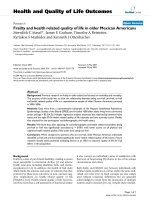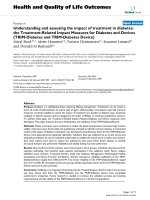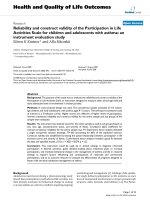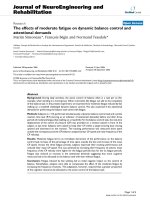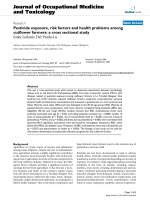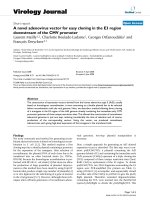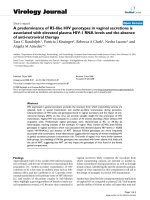báo cáo hóa học:" Migration and Risk Factors for HIV Acquisition in Pregnant Women in Baja California, Mexico" pptx
Bạn đang xem bản rút gọn của tài liệu. Xem và tải ngay bản đầy đủ của tài liệu tại đây (280.75 KB, 3 trang )
BioMed Central
Open Access
Page 1 of 3
(page number not for citation purposes)
Journal of the International AIDS Society
Short report
Migration and Risk Factors for HIV Acquisition in Pregnant
Women in Baja California, Mexico
Rolando M Viani*
1
, Maria Rosario G Araneta
2
, Jorge Ruiz-Calderon
3
,
Patricia Hubbard
4
, Graciano Lopez
5
, Enrique Chacón-Cruz
5
and
Stephen A Spector
6
Address:
1
Assistant Clinical Professor of Pediatrics, Department of Pediatrics, Division of Infectious Diseases, University of California San Diego,
School of Medicine, San Diego, California,
2
Assistant Professor of Pediatrics and Family Medicine, Department of Pediatrics and Family Medicine,
University of California San Diego, School of Medicine, San Diego, California,
3
Attending Physician, Department of Obstetrics and Gynecology,
Tijuana General Hospital, Tijuana, Mexico,
4
Program Coordinator, UCSD Mother Child and Adolescent HIV Program, San Diego, California,
5
Attending Physician, Department of Pediatrics, Tijuana General Hospital, Tijuana, Mexico and
6
Professor of Pediatrics, Department of Pediatrics,
Division of Infectious Diseases, University of California San Diego, School of Medicine, San Diego, California
* Corresponding author
As of December 2000, the US census indicated that more
than 8.7 million people of Mexican origin resided in Cal-
ifornia, with economic and social factors being the driving
force for migration.[1] Baja California is a leading point of
entry to the United States, with the Tijuana-San Diego
border crossing being the busiest land port of entry in the
world, with more than 131,000 legal border crossings
daily. Therefore, Tijuana offers a unique opportunity to
study the risk factors for HIV acquisition and migration
patterns at the Mexico-US border.
Beginning in 1997, the University of California San Diego
Mother, Child and Adolescent HIV Program established a
collaboration with pediatricians and obstetricians who
provide HIV care in Tijuana, Baja California, Mexico.[2]
We recently conducted a cross-sectional study to evaluate
the feasibility and acceptance of counseling and rapid HIV
testing during pregnancy at Tijuana General Hospital.[3]
Part of our study focused on internal migration patterns
and risk factors for HIV acquisition. Between September
and December 2003, information on residence during the
previous 5 years was available for 1496 pregnant women
at Tijuana General Hospital. Of these, 1017 resided in
Tijuana in the previous 5 years, whereas 479 resided in
other states in the previous 5 years, most of whom
migrated from Sinaloa, Michoacan, Jalisco, Chiapas, and
other cities in Baja California (Figure 1).
Migrants were defined as women who had resided in
Tijuana for less than 5 years, whereas Tijuana residents
were defined as those living in Tijuana for the previous 5
years. Migrants and Tijuana residents were similar with
regard to marital status, mean number of lifetime sex part-
ners, having 5 lifetime sex partners, number of prenatal
care visits, and having a spouse or partner with prior
blood transfusions or a spouse or partner who had sex
with men. Tijuana residents were older (27.0 vs 25.1
years; P = .04), more likely to use injection drugs (7.4% vs
4.0%; P = .011) or other drugs (10.7% vs 6.9%; P = .018),
more likely to have received a blood transfusion (11.9%
vs 7.9%; P = .03), and were more likely to have a spouse
or partner who uses injection drugs (12.5% vs 7.1%; P =
.007) or other drugs (32.8% vs 21.7%; P 0002) (chi-
square test). HIV prevalence did not differ among
migrants (7 of 479; 1.46%) and Tijuana residents (7 of
1017; 0.69%) (P = .16, Fisher's exact test). The modes of
HIV acquisition among the 14 HIV-infected pregnant
women were as follows: injection drugs for 2 women (1
received a blood transfusion), other drugs (predomi-
nantly crystal methamphetamine) for 5 women, spouse
Published: 22 June 2009
Journal of the International AIDS Society 2005, 7:69
This article is available from: />Journal of the International AIDS Society 2005, 7:69 />Page 2 of 3
(page number not for citation purposes)
received a blood transfusion for 1 woman, spouse used
other drugs for 1 woman, spouse had sex with other
women for 2 women, and no risk factors were identified
for 3 women.
The HIV prevalence among pregnant Tijuana residents
was found to be 10 times higher than the HIV prevalence
in pregnancy reported by the Mexican National Center for
HIV/AIDS Prevention and Control (CENSIDA) in other
areas of Mexico, which is 0.09%.[4] This discrepancy may
be explained by the nature of the population studied. Our
study was hospital based, with 24% of our patients having
no prenatal care before delivery and 54% having 2 or
fewer prenatal visits; therefore, this was a high-risk popu-
lation.[3] In contrast, the CENSIDA surveillance studies
were conducted between 1990 and 1999 among women
accessing prenatal care clinics; therefore, these women
were at lower risk for HIV acquisition.[5] Furthermore,
our studies that documented higher HIV prevalence in
Tijuana pregnant residents may reflect an emerging phe-
nomenon.[2,3]
Our study suggests that 32% of pregnant women who give
birth at Tijuana General Hospital have recently migrated
from other Mexican cities or states and their HIV seroprev-
alence is similar to the pregnant women who are long-
term Tijuana residents. However, Tijuana residents were
significantly more likely to engage in high-risk behavior
for HIV acquisition. Although our study did not address
the intention of these migrant women to return to their
home communities, HIV surveillance is needed in these
communities. In our study, migration was not associated
with risk of HIV acquisition; however, studies in South
Africa had found a higher rate of HIV infection among
women who migrate to urban settings.[6]
We believe that our finding of high HIV seroprevalence
among pregnant women who are long-term Tijuana resi-
dents and those who recently migrated to Tijuana from
various Mexican states emphasizes the need for continued
HIV surveillance and implementation of preventive inter-
ventions throughout Mexico. Further research is needed
in other at risk populations in Tijuana and other border
cities throughout the US-Mexico border.
Funding Information
Supported by the NIH CFAR Supplement 2 P30 AI36214-
09A1, State of California's University-wide AIDS Research
Program IS02 SD 701 and ID03 SD 029, and AI3614
(Virology Core of the UCSD Center for AIDS Research).
Also partially supported by the San Diego EXPORT
Center, National Center of Minority Health and Health
Disparities, NIH P60 MD00220
Authors and Disclosures
Rolando M. Viani, MD, MTP, has disclosed no relevant
financial relationships.
Maria Rosario G. Araneta, PhD, has disclosed no relevant
financial relationships.
Jorge Ruiz-Calderon, MD, has disclosed no relevant finan-
cial relationships.
Patricia Hubbard, MD, has disclosed no relevant financial
relationships.
Graciano Lopez, MD, has disclosed no relevant financial
relationships.
Enrique Chacón-Cruz, MD, has disclosed no relevant
financial relationships.
Stephen A. Spector, MD, has disclosed no relevant finan-
cial relationships.
References
1. US Census Bureau: United States Census 2000 report. [http://
wwwcensus.gov/Press-Release/www/2001/sumfile1.html]. Accessed
November 16, 2004
2. Viani RM, Ruiz-Calderon J, Van Pratt C, Lopez G, Spector SA: HIV
prevalence during pregnancy in Tijuana, Baja California,
Mexico. AIDS 2003, 17:1113-1114. Abstract
Map of MexicoFigure 1
Map of Mexico. States of origin of migrating pregnant
women, Tijuana General Hospital 2003. 1 indicates Baja Cali-
fornia; 2, Sinaloa; 3, Jalisco; 4, Michoacan; and 5, Chiapas.
US-MEXICO BORDER
1
2
3
4
5
Publish with BioMed Central and every
scientist can read your work free of charge
"BioMed Central will be the most significant development for
disseminating the results of biomedical research in our lifetime."
Sir Paul Nurse, Cancer Research UK
Your research papers will be:
available free of charge to the entire biomedical community
peer reviewed and published immediately upon acceptance
cited in PubMed and archived on PubMed Central
yours — you keep the copyright
Submit your manuscript here:
/>BioMedcentral
Journal of the International AIDS Society 2005, 7:69 />Page 3 of 3
(page number not for citation purposes)
3. Viani RM, Araneta MR, Ruiz-Calderon J, et al.: HIV-1 infection in a
cohort of pregnant Women in Baja California, Mexico: evi-
dence of an emerging crisis? [ThPeC7301]. Program and
abstracts of the XV International AIDS Conference; July 1116, 2004; Bang-
kok, Thailand .
4. CENSIDA, Panorama Epidemiologico del VIH/SIDA e ITS
en Mexico Secretaria de Salud, Mexico City, Mexico 2004 [http://
www.salud.gob.Mx/C0NASIDA]. Accessed September 30, 2004
5. del Rio C, Sepúlveda J: AIDS in Mexico: lessons learned and
implications for developing countries. AIDS 2002,
16:1445-1457. Abstract
6. Zuma K, Gouws E, Williams B, Lurie M: Risk factors for HIV infec-
tion among women in Carletonville, South Africa: migra-
tion, demography and sexually transmitted diseases. Int J STD
AIDS 2003, 14:814-817. Abstract


